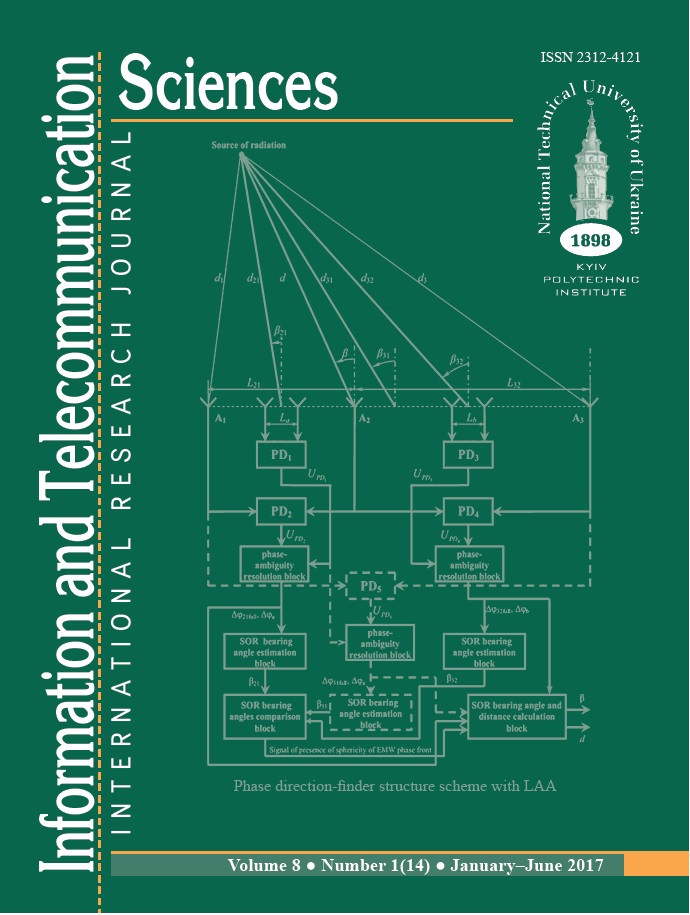FILTRATION OF PARAMETERS OF THE UAV MOVEMENT AT COMPLEX USE OF DATA SENSOR NETWORKS, OBTAINED BASED ON THE TDOA AND RSS METHODS
DOI:
https://doi.org/10.20535/2411-2976.12017.31-36Keywords:
UAV, TDOA, RSS, the expanded Kalman filter, wireless sensor network, parameters of movement.Abstract
Background. At the present time the development of technologies for construction of unmanned aerial vehicles (UAVs) are used for the solution of a wide range of tasks, such as: emergency rescue operations, autonomous observation and monitoring of industrial processes and environment (fauna monitoring), etc. On the other hand, their availability and massive use for a wide range of problems has led to the emergence of a new class of threats: application in terrorist purposes, photographing of secret objects, receiving unauthorized access to information in WLAN networks, invasion on the forbidden territory, etc. This leads to the need to develop security systems that solve the problem of detection, positioning and movement parameters of the UAV.
Objective. Synthesize algorithm the filtration of parameters of the UAV movement at complex use of data, obtained based on the TDOA and RSS methods.
Methods. Synthesis of algorithm the filtration of parameters of the UAV movement at complex use of data, obtained based on the TDOA and RSS methods, it is executed on the basis of the mathematical device of the extended Kalman filter. Efficiency analysis of a developed algorithm is carried out by means of statistical modeling. For descriptive reasons of the algorithm works the test trajectory of the UAV movement has been created.
Results. As appears from results of modeling, complex use of data allows reducing RMS errors of the position estimation of the UAV more, than by 3 times, in comparison with independent processing on the basis of the data obtained by the TDOA and RSS methods..
Conclusions. The algorithm filtration of parameters of the UAV movement synthesized on the basis of a mathematical apparatus of the expanded Kalman filter is recurrent and implements a sequential procedure for combining data obtained on the basis of the TDOA and RSS methods. The developed algorithm takes into account the dispersion of power measurement errors, received signals by sensors of the sensor network and determines the estimate of the unknown error of measuring the arrival time signal of the reference sensor.
References
Nonami K., Kendoul F., Suzuki S., Wang W., Nakazawa D. (2010) Autonomous Flying Robots Unmanned Aerial Vehicles and Micro Aerial Vehicles, N. Y., Springer, 329 p. DOI: 10.1007/978-4-431-53856-1
Wallace, R. J., Loffi , J. M. (2015) Examining Unmanned Aerial System Thr eats & Defenses: A Conceptual Analysis, International Journal of Aviation, Aeronauti- cs, and Aerospace, Volume 2, Issue 4, 33 p. DOI: 10.15394/ijaaa.2015.1084
Zashchita ot dronov – nebesnyy rubezh vashey bezopasnosti [Electron resource] – Access mode to the resource: http://dronebouncer.com/
Jose L. Rullan-Lara, Guillaume Sanahuja, Rogelio Lozano, Sergio Salaza, Ramon Garcia-Hernandez, Jose A. Ruz-Hernandez . “Indoor Localization of a Quadrotor Based on WSN: A Real-Time Application”,
International Journal of Advanced Robotic Systems, 2013, Vol. 10, 48:2013.
Tarrno P., Bernardos A. M., Casar J. R. (2007) An RSS Localization Method Based on Parametric Channel Models, IEEE, International Conference on Sensor Technologies and Applications, pp. 265-270.
Mao G., Fidan B., Anderson B. D.O. (2007) Wireless Sensor Network
Localization Techniques, Journal Computer Networks: The International Journal of Computer and Telecommunications Networking archive, Volume 51, Issue 10, pp. 2529-2553.
Alon Amar, Geert Leus. “A reference-free time difference of arrival source localization using a passive sensor array”, IEEE Sensor Array
and Multichannel Signal Processing Workshop, 2010, pp. 157-160.
Tovkach, I. O., Zhuk, S. Ya. (2016) Recursive algorithm of the passive
location in sensor networks based on measurement of the received signal strength, Visn. NTUU KPI, Ser. Radioteh. radioaparatobuduv., no. 66, pp. 46-55.
Masieroa A., Fissorea F., Guarnieria A., Pirottia F., Vettorea A. (2015) UAV positioning and collision avoi- dance based on RSS measurements,
The International Archi- ves of the Photogrammetry, Remote Sensing and Spatial Information Sciences, Volume XL-1/W4, pp. 219- 225.
“Sravneniye metodov opredeleniya geograficheskogo mestopolozheniya istochnika signala, osnovannykh na raznitse vo vremeni prikhoda i ugle prikhoda signala” Otchet MSE-R SM.2211-1 Zheneva, 2015 g.
Neuimin O. S., Zhuk S. Ya. Sequential detection of target trajectory
using the decision statistics of pips. Radioelectronics and Communications
Systems, 2014, vol. 57, no. 8, pp. 352-361. doi:10.3103/S0735272714080032.
Yevlanov P.A., Zhuk S.YA. (1990) Kompleksirovaniye izmeriteley
s otkazami, Izvestiya vuzov USSR. Radioelektronika, Vol. 33, No. 3. pp. 15-21.

